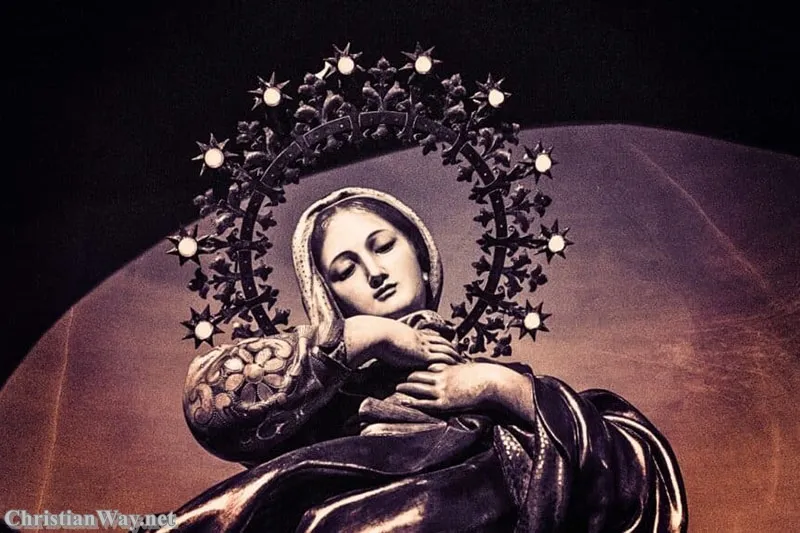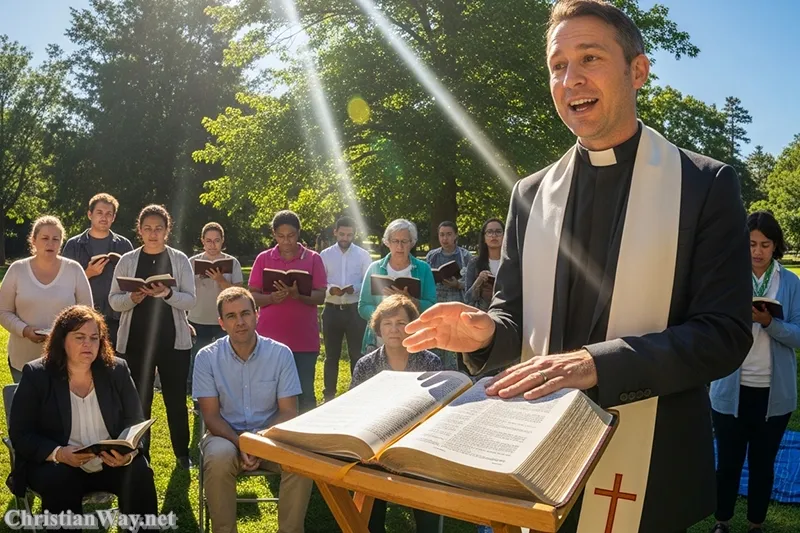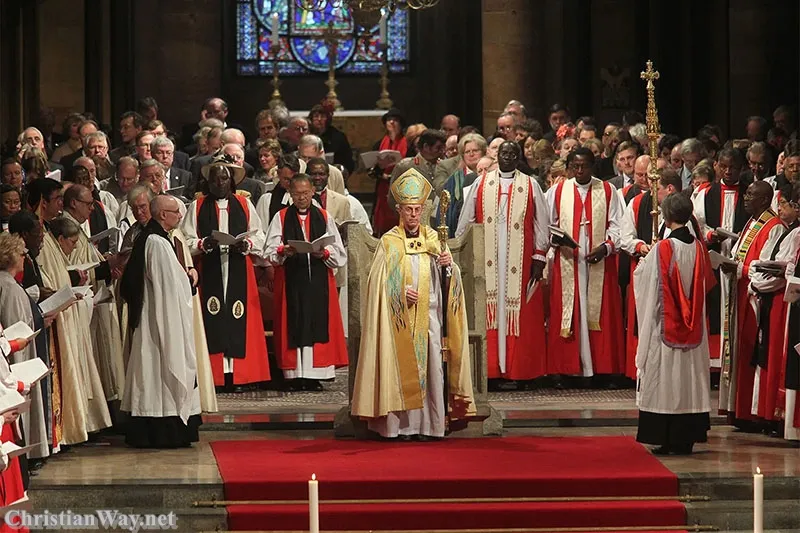Dear friends in Christ,
Among the most tender and yet profound figures in all of Christian faith stands the Blessed Virgin Mary — a young woman whose humble “yes” to God changed the course of history. Within Anglicanism, as in all Christian traditions, Mary holds a place of deep reverence — not as an object of worship, but as the first and most faithful disciple of her Son. She is honored as Theotokos, the “God-bearer,” and remembered as the one through whom the Word became flesh.

The Anglican approach to Mary is marked by balance: a devotion that honors her faith and obedience, while always centering worship on Christ alone. To understand Mary in Anglican faith is to see her not as distant or idealized, but as one who reveals what it means to live in perfect trust and surrender to God.
Mary as the First Disciple of Christ
From the moment she receives the angel’s message — “Behold, I am the handmaid of the Lord; let it be to me according to your word” (Luke 1:38) — Mary steps into the mystery of discipleship. She is the first to hear the Gospel, the first to believe, and the first to bear Christ to the world.
Anglican theology often returns to this image of Mary as the faithful disciple: one who listens, believes, and responds in love. Her faith is not passive; it is active, courageous, and deeply human. She questions the angel, she ponders all things in her heart, she endures suffering beneath the Cross. In every stage of her journey, she lives the call of every Christian — to trust when understanding fails, and to love when the cost is great.
The Word Made Flesh in Her Life
The mystery of the Incarnation — “the Word became flesh and dwelt among us” (John 1:14) — is not an abstract doctrine in Mary’s story. It is the reality of her own body and life becoming the dwelling place of God. In Anglican reflection, Mary becomes the living sign that God chooses to work through human frailty, that holiness is not distant but woven into the fabric of our humanity.
Her “yes” reveals the divine humility that meets human freedom, and her womb becomes the meeting place of heaven and earth. Thus, she stands at the heart of the Christian mystery — the bridge between creation and the Creator.
The Anglican Balance: Honor Without Excess
One of the defining characteristics of Anglican spirituality is its via media — the “middle way” between extremes. In devotion to Mary, this balance is especially evident.
Anglicans, following the early Church, affirm Mary’s titles — Theotokos (God-bearer), Blessed Virgin, and Mother of our Lord. They recite her Magnificat daily in the Evening Prayer:
“My soul magnifies the Lord,
and my spirit rejoices in God my Savior.” (Luke 1:46–47)
This daily remembrance roots Mary deeply in Anglican worship. Yet, unlike traditions that promote extensive Marian devotions or intercessions, Anglicanism maintains that prayer and worship are directed to God alone — Father, Son, and Holy Spirit.
In this way, Mary is honored as a witness, not worshiped as a divine figure. She points always toward Christ. As one Anglican theologian wrote: “We honor Mary most when we follow her example — to do whatever He tells us.”
The Magnificat and the Anglican Heart
The Magnificat, sung at Evening Prayer, is perhaps the most distinctly Anglican way of keeping Mary close to daily faith. It is her song of praise — but also the Church’s song. In it, the humble are lifted, the hungry are filled, and the mercy of God endures from generation to generation.
For Anglicans, Mary’s Magnificat embodies the Gospel’s social and spiritual vision: God overturning the proud, redeeming the poor, and fulfilling His promises to His people. It is a vision that flows into Anglican social teaching, mission, and prayer life — reminding believers that divine grace is not merely personal but transformative for the whole world.
Mary in Scripture and Anglican Tradition
The Anglican tradition, rooted in Scripture and the early creeds, holds Mary in high esteem precisely because of what the Bible reveals about her. Every major Anglican confession of faith — from the Thirty-Nine Articles to the Book of Common Prayer — affirms her unique role in salvation history.
She is remembered as:
- The Mother of Jesus, who bore the Incarnate Word.
- The Blessed Virgin, a model of purity and trust.
- The Servant of the Lord, whose obedience became the door of salvation.
- The Figure of the Church, in whom faith and fruitfulness meet.
In the Communion of Saints
Anglicans confess in the Creed, “I believe in the communion of saints.” This includes Mary, not as one apart from the Church, but as the first and greatest member of it. She is “blessed among women,” not because she was spared the ordinary struggles of faith, but because she lived them fully in union with God’s will.
In many Anglican churches, her feast days are still kept — the Annunciation (March 25), the Visitation (May 31), the Nativity of Mary (September 8), and the Assumption (or Dormition, August 15) where observed. These days are not times of Marian-centered worship, but moments of thanksgiving for God’s grace revealed through her.
The Theology of Grace in Mary’s Life
In Mary’s story, Anglicans perceive the heart of divine grace. Grace does not erase human weakness; it transforms it. Mary’s holiness is entirely God’s gift — not a personal achievement but a participation in divine mercy.
When the angel greets her, saying, “Hail, full of grace, the Lord is with you” (Luke 1:28), he reveals not merely her virtue, but God’s favor. The same grace that filled Mary is offered to every believer in Christ.
Thus, Mary is not distant from us — she is near, for the grace that made her “blessed” is the same grace that sanctifies the Church.
Mary and the New Creation
Anglican thinkers have often described Mary as the beginning of God’s “new creation.” Just as Eve once said “no” to God’s command, Mary’s “yes” opens the door for redemption. In her, humanity begins again — healed, renewed, reconciled.
Her obedience heals the disobedience of Eden, not by her power but through her openness to God’s Spirit. This vision of Mary as the “New Eve” is shared across Catholic, Orthodox, and many Anglican theologians, expressing the universal Christian truth that salvation begins in the soil of human freedom and trust.
The Pastoral Example of Mary
To speak of Mary in Anglicanism is not only to explore doctrine but to touch the heart of devotion. She stands before believers as a mother in faith — gentle, steadfast, prayerful.
Anglican spirituality often emphasizes her quiet strength: her contemplation, her endurance at the Cross, her presence among the apostles at Pentecost. She is a model of perseverance in prayer, especially for those who suffer silently.
When we meditate on Mary, we learn how to wait, how to believe without seeing, and how to hold both joy and sorrow in the same heart.
Mary and the Christian Life Today
For the Anglican believer today, Mary remains a companion in discipleship. In her humility, we see what it means to trust God in uncertainty. In her pondering heart, we find the pattern of contemplative faith. In her song, we hear the rhythm of God’s mercy for the poor and forgotten.
Her example calls the Church to holiness — not perfectionism, but surrender. Not pride, but gratitude. She teaches us that the truest response to God’s will is always love.
Mary and Ecumenical Unity
One of the quiet gifts of Mary is her power to draw Christians closer together. While devotion to her varies among traditions, she stands as a figure of unity rather than division.
Catholics and Orthodox revere her deeply; Protestants honor her as the mother of the Savior; Anglicans hold her as the faithful servant and exemplar of grace. In her, the whole Body of Christ can glimpse a shared heritage — the woman who bore the Redeemer for all nations.
In recent dialogues between Anglicans and other Christian communities, Mary has often been a bridge for understanding. Her life reveals what redeemed humanity looks like — receptive, obedient, joyful in God.
The Mystery of Mary’s Faith
Mary’s life remains a mystery of faith, not because it is distant, but because it mirrors every believer’s journey. Her story invites us into a deeper trust in God’s promises.
She believed the impossible: that a virgin could bear a child; that the lowly would be lifted up; that death would give way to resurrection.
Her faith stands as a lamp for the Church — not replacing Christ’s light, but reflecting it purely. Every time we pray the words of her song, every time we ponder her quiet faith, we are reminded that God still enters the world through hearts that say “yes.”
Reflect and Pray
The Virgin Mary in Anglicanism stands not as a subject of controversy, but as a gentle guide toward Christ. Her life is a mirror of grace — unpretentious, faithful, radiant with the light of divine love.
May her example lead us to trust as she did, to surrender as she did, and to magnify the Lord in every corner of our lives.
Prayer
O God, who chose the Blessed Virgin Mary to be the mother of your Son,
grant that we, who rejoice in her obedience and faith,
may, by your grace, share in her humility and joy.
May Christ be formed in us,
and may our souls, too, magnify your holy name.
Through the same Jesus Christ our Lord. Amen.
— Fr. John Matthew, for Christian Way





